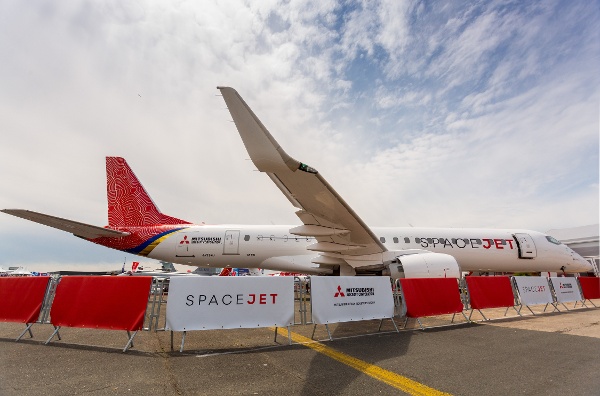
In announcing its third quarter FY22 financial results, Mitsubishi Heavy Industries (MHI) revealed that it has decided to officially discontinue development activities for the company’s SpaceJet series of regional jetliners. Most such activities have been suspended since October 2020.
MHI said that it intends to leverage the knowledge and experience acquired through the SpaceJet program to continue contributing to the Japanese aviation industry, which aspires to return OEM aircraft manufacturing to the country.
Among the reasons listed by MHI for the program termination was that the SpaceJet needed partial technological revisions due to its prolonged development, including decarbonization solutions. In addition, the manufacturer indicated that it was difficult to obtain understanding and necessary cooperation from global partners.
MHI also noted that little progress had been made on scope clause relaxation in the North American market, resulting in the lead SpaceJet M90 variant not meeting the needs of that market. The company also said that recent pilot shortages added to the uncertainty of the SpaceJet’s business viability.
Finally, MHI said that additional extensive funding would be required to continue the SpaceJet’s type certification process, and that the business was not feasible in the present market environment.
Mitsubishi said that the lessons learned from its experience with the SpaceJet were that there was insufficient initial understanding of the complex type certification process for commercial aircraft and there were insufficient resources to continue long-term development.
The SpaceJet was well into its flight test campaign when development was paused in the fall of 2020. MHI had conducted more than 3,900 hours of flight testing with no safety issues.
The SpaceJet was originally known as the Mitsubishi Regional Jet (MRJ), but was rebranded in mid-2019. The series consisted of two models. The lead variant was the M90, which could accommodate 88 passengers in a typical single-class configuration. The M90 had a range with 88 passengers of 2,040 nautical miles. Maximum takeoff weight was 42,800 kilograms (94,358 lb). MHI built six examples of the M90.
The second model in the series was the M100, which could be configured in a 76-seat, three-class layout in order to meet scope clause restrictions in the U.S. market. In this configuration, its maximum takeoff weight was 39,008 kilograms (86,000 lb). No M100s were ever built. Both the M100 and M90 were powered by a pair of Pratt & Whitney PW1200G geared turbofan engines.
The M100 was designed expressly to meet the requirements of scope-impacted U.S. carriers. Scope clause restrictions severely limited sales opportunities for the larger M90 in the U.S. market. Such clauses in pilot contracts at the three U.S. major carriers prohibit their regional airline partners from operating any aircraft that has a maximum takeoff weight exceeding 86,000 pounds or (with one exception) that seats more than 76 passengers. The M90 could be configured with a scope-compliant 76-seat layout, but it would still have exceeded the 86,000-pound weight limit. Flying the M90 at a weight below that level would have entailed a sacrifice in range.
Going forward, MHI plans to continue its activities as OEM on the CRJ regional jet program acquired from Bombardier. The CRJ family is no longer in production, but extensive service and support business exists with the large in-service fleet. MHI also intends to deepen partnerships with global OEMs, consider next-generation technologies with an eye toward aircraft development programs, and apply its knowledge and experience to Japan’s F-X fighter program. The company also intends to repurpose the facilities and equipment in Japan’s Aichi Prefecture that had been developed for the SpaceJet program.
Raymond Jaworowski currently co-authors three of Forecast International's best-selling products: Civil Aircraft Forecast, Military Aircraft Forecast, and Rotorcraft Forecast. As a contributor to Aviation Week & Space Technology's Aerospace Source Book, he has authored Aircraft Outlooks, and provided input for the publication's Aircraft Specifications tables. Raymond has represented Forecast International at numerous conferences and trade shows, often as a featured speaker. He is a member of the American Helicopter Society.




